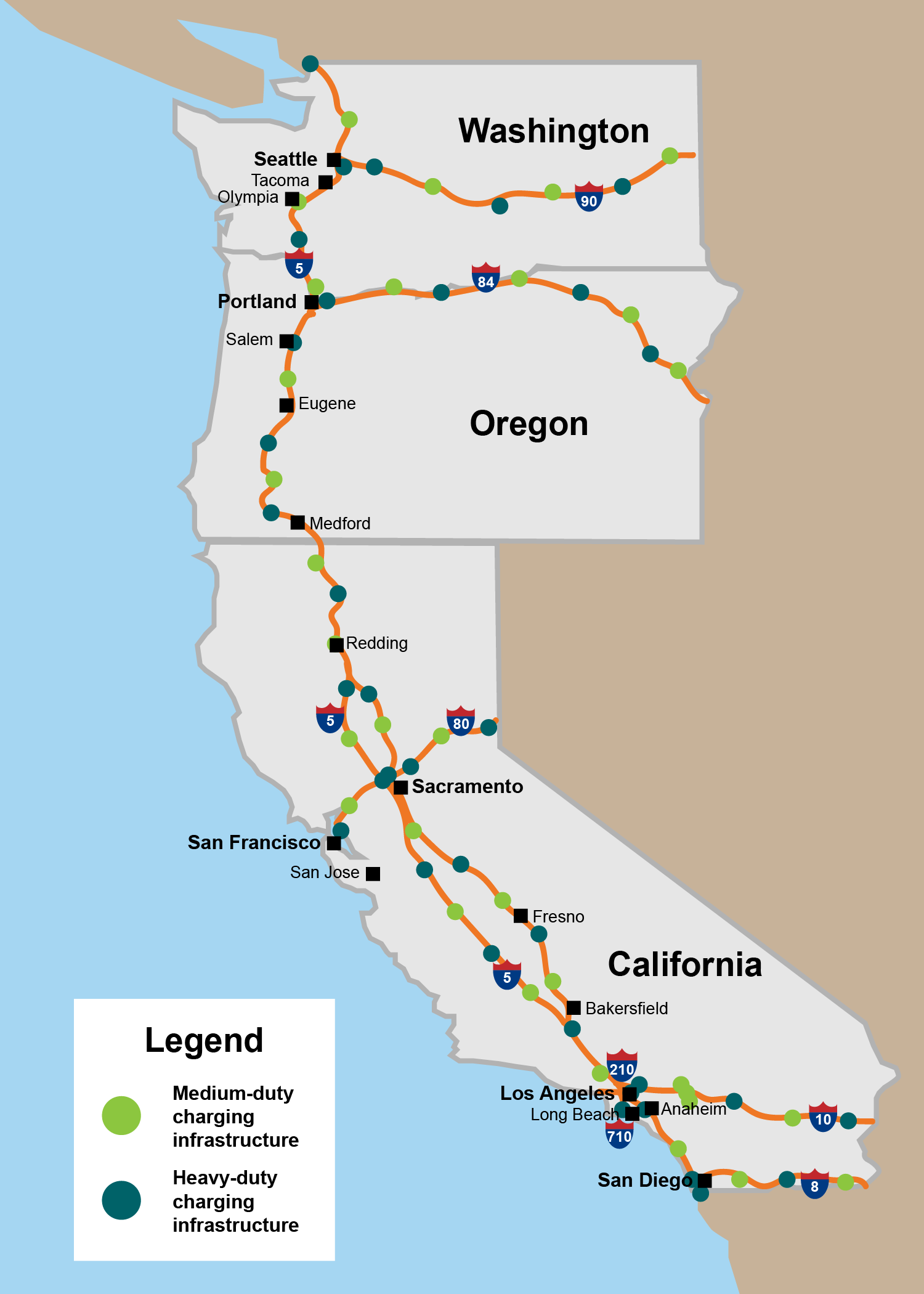States are making significant moves to get electric and automated trucks on the road. An electric truck corridor is in the works on the West Coast, while an automated corridor is coming to Ohio.
West Coast electric trucks corridor
On June 17, electric utility companies in three West Coast states announced the results of the West Coast Clean Transit Corridor Initiative study. The study looked into electric charging stations in the region to accommodate trucks.
The study recommends adding electric charging stations for freight haulers and delivery trucks at 50-mile intervals along Interstate 5 and adjoining highways. Once approved, the project would be rolled out in phases.

Phase one involves installing 27 charging sites along I-5 at 50-mile intervals for medium-duty electric vehicle by 2025. Delivery vans are considered medium-duty electric trucks. After that, the role of charging stations will expand. Phase two includes accommodating heavy-duty trucks at 14 of 27 charging sites by 2030. According to a new release, 8% of all trucks on California roads are expected to go electric.
Not all of the electric truck charging stations will be in California. Five will be in Oregon, six in Washington and the remaining 16 in California.
I-5 will not be the only highway included.
An additional 41 charging sites on other highways are also part of the proposal. Recommended highways are Interstates 8, 10, 80, 210 and 710; state Routes 60 and 99 in California; I-84 in Oregon; and I-90 in Washington.
However, there are some obstacles to overcome. Although most utilities have enough capacity in urban areas to support medium-duty charging sites, few rural areas have that ability. According to the study, no rural area in the studied region has the capacity to accommodate heavy-duty trucks. Funding is another issue. The report recommends expanding state, federal or private programs.
Additionally, the report recommends further clean fuel policies. On Thursday, June 25, the California Air Resources Board will vote on the Advanced Clean Truck standard. If passed, it will be the nation’s first electric trucks manufacturing standard.
Study sponsors include:
- Los Angeles Department of Water and Power.
- Northern California Power Agency.
- Pacific Gas and Electric Co.
- Pacific Power.
- Portland General Electric.
- Puget Sound Energy.
- Sacramento Municipal Utility District.
- San Diego Gas and Electric Co.
- Seattle City Light.
- Southern California Edison.
- Southern California Public Power Authority.
The study assumes medium-duty electric trucks will have an average range of 90-120 miles during the next five years. It also assumes the average range for heavy-duty trucks will be 230-325 miles over the next decade.
Automated trucks corridor in Ohio
Meanwhile, Ohio has received $4.4 million from the U.S. Department of Transportation for truck-focused automated driving technology.
The Federal Highway Administration awarded DriveOhio $4.4 million for its Interstate 70 Truck Automation Corridor project. The funding is part of the Advanced Transportation and Congestion Management Technologies Deployment Program. Supported by the Ohio Department of Transportation, DriveOhio is a collaboration of private and public entities addressing smart mobility projects.
The I-70 Truck Automation Corridor project aims to deploy smart logistics solutions along a stretch of I-70 between Columbus, Ohio, and Indianapolis. To do this, that corridor will be open for freight companies and truck automation vendors to deploy partially automated trucks driving tech in daily revenue service operations.
Participating fleets will be allowed to offer driver training for automated trucks driving technology along the corridor. The Transportation Research Center will collect data from an automation audit. After that, data will be provided to ODOT and its partners to ensure Ohio roadways are ready for partially automated trucks. Also, data will also be sent to the U.S. Department of Transportation to guide policies and procedures at the federal level.
There are some conditions. During public road testing, a human driver will always be at the wheel in case human intervention is needed.
According to a DriveOhio news release, the project will last four years. Data gleaned from the corridor is expected to support technological innovation. The I-70 Truck Automation Corridor project is a collaboration between ODOT, DriveOhio, the Indiana Department of Transportation, and the Transportation Research Center. With partners contributing $4.5 million in matching funds, the total investment in for this project is $8.9 million.
Related stories:
"electric" - Google News
June 25, 2020 at 02:51AM
https://ift.tt/3dt0RmJ
Electric and automated truck corridors coming soon - Land Line - Land Line Media
"electric" - Google News
https://ift.tt/2yk35WT
https://ift.tt/3bbj3jq
No comments:
Post a Comment